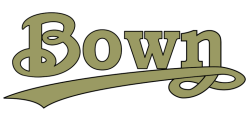

Bown Manufacturing Company of Æolus Works, Summer Lane, Snow Hill, Birmingham, produced motorcycles from 1914 to 1923.
1862 The factory was established by William Bown and the marque is related to Aberdale and Levis. The Aeolus name was trademarked in 1877 and used extensively on bicycle components, including ball bearings for which he held a patent, one of many [1]. Towards the turn of the century the company had over 1000 employees. W. Bown died in 1900 and a family member took over.
1913 According to some sources Bown was associated with Aeolus motorcycles as early as 1913, however there is no mention of either name in The Motor Cycle during the latter half of 1913.[2]
1914 The machines were very basic and powered by a 269cc Villiers two-stroke engine with front-mounted magneto ignition. Single or two-speeds were available, both with belt final-drive. Petroil lubrication and Druid forks were used. A 2hp Precision engine was available as an option.
1912 Models
1914 Models
BOWN-VILLIERS.
Engine - 2¼ h.p. Villiers, two-stroke, 269 c.c.
Iqnition - High-tension magneto.
Carburetter - B. and B. or Amac.
Change Speed - Two-speed in counter-shaft.
Transmission - Dunlop belt.
Lubrication - Oil mixed with petrol.
Other Features - Druid forks. Dunlop or Continental tyres, 26x2.
Price - £35, or single-geared £27 10s.
Other Models -Similar machine fitted with 2 h.p. Precision unit.
Bown manufacturing Co., Snow Hill, Birmingham.
1915 That model continued and then all production ceased.
1921 Late that year four models were produced - two two-strokes and two four-strokes. One of the two-strokes was little changed since before the war, with a 269cc Villiers engine and flywheel magneto. The other, listed as a Bownian, was smaller and simpler. Of the four-strokes, one had a 348cc Blackburne engine driving a three-speed gearbox and the other had a 293cc JAP engine and two speeds.
From 1922 to 1924 William Bown assembled small Villiers-powered machines of 147cc capacity, and also 248cc and 348cc JAP and Blackburne powered machines.
1922 Only the models with Villiers engines were listed.
1923 Just one model, with a 147cc Villiers engine was available. It was to be Bown's last year.
Note: Taken over by Aberdale in the 1930's, Bown is associated with Aberdales from 1946 to 1949 and Levis from 1950 to 1958. From 1950 to 1958 the Bown marque was associated with autocycles of 98cc and 123cc with engines by Villiers, and after 1955 they also built Sachs-powered mopeds.
Bown were motorcycles produced from 1950 to 1957.
Until 1949 they built the autocycle for Aberdale of London, and in that year adopted the Bown name.
1950 Having revised their autocycle design, they used a 99cc Villiers 2F engine with a cradle frame fitted with blade girder forks and enclosing side panels below the petroil tank.
1951 The firm added a small motorcycle to their list. It had a 99cc two-speed Villiers 1F engine, neatly fitted into a frame with duplex downtubes and tubular girder forks.
1952 Those two models were joined by their Tourist Trophy which was fitted with a 122cc Villiers 10D engine and telescopic forks.
1953 The range continued in that form.
1954 Production stopped.
1956-1957 The name returned for only two years. It was used for an imported German moped with a 47cc Sachs engine.
Notes
1. William Bown did not invent the ball bearing. This laurel goes to Leonardo da Vinci, who created it as a solution for the rotor drive on his helicopter.
2. The Aeolus marque was used on a motorcycle as early as 1903 by E. H. Owen in London. There does not appear to be a relationship.
Sources: Graces Guide, The Motor Cycle, Wikipedia, et al.
If you have further information or a query related to this page, please contact us